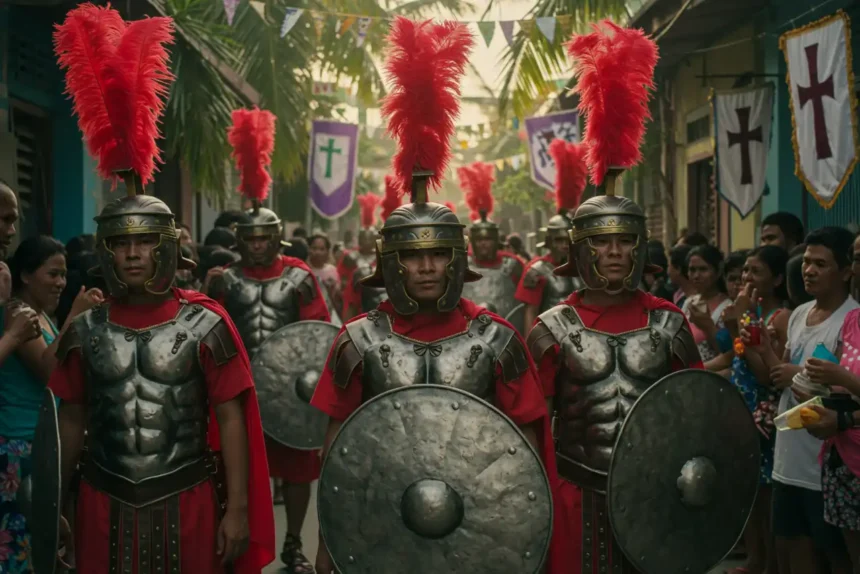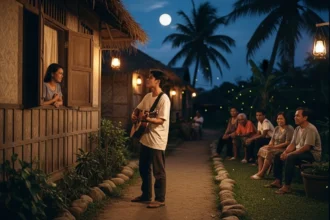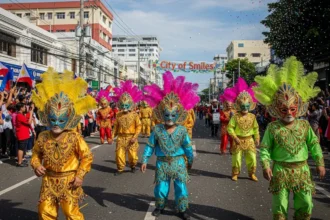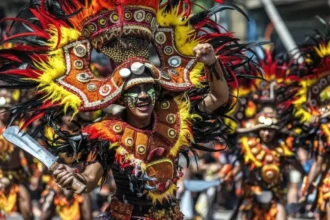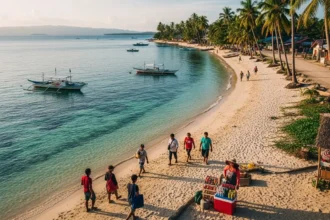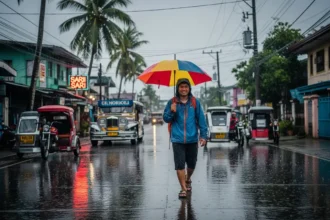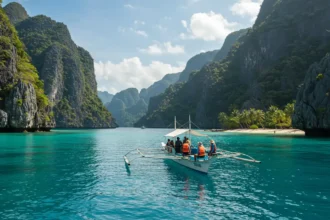Every Holy Week, the island of Marinduque transforms into a stage for one of the most dramatic and deeply rooted Filipino traditions – the Moriones Festival.
From Palm Sunday to Easter Sunday, locals dressed as Roman centurions roam the streets in vibrant masks and armor, reenacting the biblical story of Longinus, the blind Roman soldier whose sight was miraculously restored during Christ’s crucifixion.
It’s part theater, part pilgrimage – and all faith. Between the sound of drums, the sight of colorful masks, and the solemn atmosphere of Lent, Moriones Festival 2026 offers a one-of-a-kind window into the Filipino soul – where devotion, art, and community come together in a powerful Holy Week celebration.
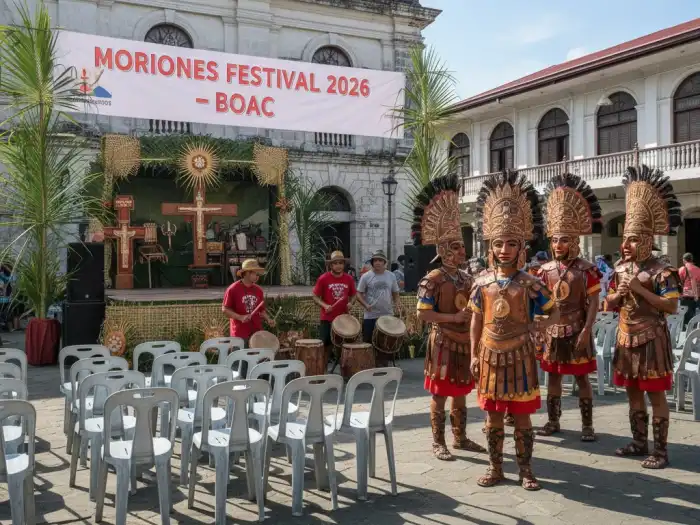
📅 2026 Schedule & Key Events
The Moriones Festival 2026 will take place during Holy Week, from March 29 (Palm Sunday) to April 5 (Easter Sunday). Every day brings something unique – from street reenactments to solemn processions – all centered on faith, penance, and the iconic masked morions wandering Marinduque’s towns.
This seven-day festival combines theater, devotion, and community artistry, with each town adding its own local touch. The main events are held in Boac, Mogpog, and Gasan, though you’ll also find smaller performances in Buenavista, Torrijos, and Santa Cruz.
Here’s what to expect for the Moriones Festival 2026 schedule:
| Date (2026) | Event / Activity | What to Expect |
|---|---|---|
| March 29 (Palm Sunday) | Opening of Moriones Festival 🌿 | Launch parade with Morions in full armor blessing palm fronds at Boac Cathedral. Town streets filled with drums and chants. |
| March 30–31 (Holy Monday–Tuesday) | Street Reenactments & Morion Patrols 🛡️ | Masked “Roman soldiers” roam the streets, playfully interacting with townsfolk and tourists. Great time for photos and cultural immersion. |
| April 1 (Holy Wednesday) | Lenten Play & Biblical Scenes 🎭 | Town plazas host short plays dramatizing Longinus’ story. Locals participate, mixing faith with folk theater. |
| April 2 (Maundy Thursday) | Processions & Church Visits ⛪ | Pilgrims visit seven churches (Visita Iglesia), while Morions maintain a solemn vigil in the background – symbolizing their search for Longinus. |
| April 3 (Good Friday) | The Passion of Christ Reenactment ✝️ | The most sacred day. Watch dramatic scenes of Christ’s crucifixion followed by the symbolic capture and “beheading” of Longinus. Deeply emotional and moving. |
| April 4 (Black Saturday) | Community Reflections & Silent Marches 🕯️ | A quiet day of penance and prayer. Morions walk without drums, reflecting the waiting before the Resurrection. |
| April 5 (Easter Sunday) | Easter Parade & Grand Moriones Procession 🌸 | Joyful celebration of the Resurrection. Morions remove their masks in thanksgiving, closing the week with prayers, music, and a community feast. |
✝️ Local Faith Tip – Join the Procession Respectfully
If you join the processions or street events, dress modestly and avoid loud behavior. Locals treat this as a sacred week, not just a festival – so show reverence even while taking photos.
📍 Festival Core Areas
-
Boac – The provincial capital and center of major religious processions.
-
Mogpog – Believed to be the birthplace of the Moriones tradition.
-
Gasan – Famous for its cultural street plays and coastal Morion parades.
Traveler’s Move – Stay Near the Action
Book accommodations in Boac or Gasan for easier access to the parades. Public transport is limited during Holy Week, so plan early and expect some road closures near churches.
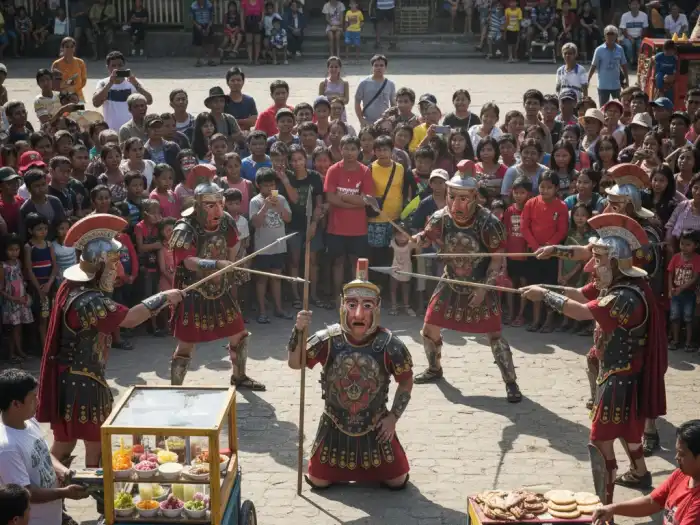
🎭 Festival Highlights & Cultural Attractions
What makes the Moriones Festival so unforgettable isn’t just its biblical roots – it’s how faith becomes theater, and how art becomes devotion. Every mask, march, and prayer echoes a story that’s been retold for more than 200 years on the island of Marinduque.
From the clang of armor to the deep chants echoing through church courtyards, it’s not just a show – it’s a spiritual experience that brings Holy Week to life in a uniquely Filipino way.
🛡️ The Iconic Morion Masks
The stars of the festival are the Morions – men and women dressed as Roman centurions wearing hand-carved wooden masks, metal helmets, and flowing capes. Each mask is a work of art, created by local artisans weeks before Holy Week.
Some look fierce with mustached faces and piercing eyes, while others carry elaborate plumes and gold paint. No two masks are ever the same – because each represents the individuality of the wearer’s devotion.
Making a mask can take days or even weeks. The process involves carving, sanding, painting, and assembling armor pieces made of wood, fiberglass, and metal scraps. Some families have been mask makers for generations – passing down the craft like an heirloom.
Cultural Gem – The Meaning Behind the Mask
Wearing the Morion mask is a form of panata – a religious vow or offering. For many, it’s an act of penance or thanksgiving for prayers answered. Behind every mask is a personal story of faith.
✝️ The Story of Longinus
At the heart of the Moriones Festival is the story of Longinus, a Roman soldier who pierced Jesus’ side during the crucifixion. According to legend, a drop of Christ’s blood touched his blind eye – and healed him instantly.
Overcome with faith, Longinus converted to Christianity, defying the Roman Empire. This angered his fellow soldiers, who eventually captured and beheaded him.
Throughout Holy Week, you’ll see this story reenacted in different ways – from street plays and town parades to the emotional Good Friday crucifixion scene. It’s both sacred and theatrical, blending faith, drama, and local creativity.
Local Insight – The Longinus Reenactment
In Boac and Mogpog, the “search for Longinus” plays out over several days, with Morions roaming the streets as if in pursuit. The final “capture” and symbolic “execution” happen on Good Friday – one of the most awaited moments of the festival.
⛪ Church Processions and Lenten Rituals
While the Morions bring color and pageantry, the festival is still deeply rooted in Catholic tradition. Daily masses, rosaries, and Visita Iglesia (visiting seven churches) remind everyone that Pahiyas is ultimately a celebration of faith and renewal.
The Boac Cathedral – built in the 18th century – becomes the spiritual center, where crowds gather for Maundy Thursday’s washing of the feet and the solemn Good Friday service.
At night, the glow of candles lights up the streets as locals walk silently in reflection, blending solemnity with spectacle in a way only the Philippines can.
Traveler’s Secret – The Silent March
On Black Saturday, join the locals in the evening procession carrying candles and flowers. It’s a quiet yet powerful moment that captures the island’s spiritual depth, far from the noise of tourism.
🎶 Music, Food, and Island Warmth
Even with its religious tone, Marinduque’s Moriones week carries the warmth of a fiesta. Drums echo in the distance, vendors sell bibingka and suman, and children run around wearing mini-Morion masks.
After the processions, families gather to share meals of adobo, pancit, and fresh seafood, welcoming visitors to their homes – a reminder that hospitality is part of faith, too.
Local Flavor – Eat Like a Devotee
Try the island’s special arrowroot cookies, bibingkang Lalaki, and pinais na isda (fish wrapped in banana leaves). Most are homemade and sold near church plazas after Mass.
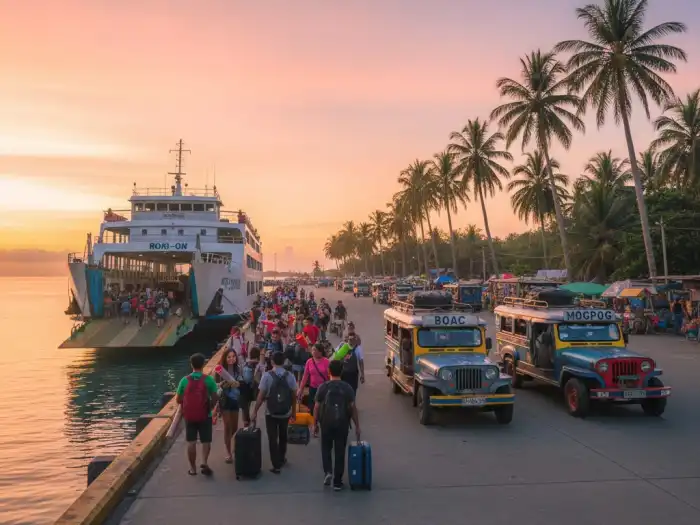
🧭 How to Get There & Travel Tips
Marinduque may be small, but reaching it for the Moriones Festival feels like a mini pilgrimage – one that’s equal parts scenic and spiritual. Nestled in the heart of Southern Luzon, the island is accessible by land and sea, and every step of the journey sets the tone for the Holy Week experience.
🚢 How to Get to Marinduque
| Route | Travel Time | Details & Tips |
|---|---|---|
| From Manila (Bus + Ferry) | 6–8 hours | Take a JAC Liner or DLTB bus from Buendia or Cubao bound for Lucena Port (Dalahican Pier) – ₱400–₱500 fare. From there, ride a RORO or fast craft to Balanacan Port (Mogpog) or Cawit Port (Boac) – ₱200–₱300. |
| From Lucena to Marinduque (Ferry only) | 3–4 hours | Multiple daily trips by Montenegro Lines, Starhorse Shipping, and JAC Liner FastCat. Bring snacks and water – there’s limited onboard food. |
| By Air (Chartered flights) | 45 minutes | Limited flights from Ninoy Aquino International Airport to Marinduque Airport (Gasan) via Cebgo or chartered small planes. Book months ahead – seats sell fast during Holy Week. |
Traveler’s Timing Trick – Leave Early Holy Monday
Ferries fill up fast by Holy Wednesday, so if you can, leave two to three days before to avoid the crowd and ensure a smooth ride. Arriving early also gives you time to explore Boac’s old-town charm before the main events begin.
🏨 Where to Stay During Moriones Festival
Hotels and homestays are limited on the island, and most are fully booked by March – so it’s best to reserve early.
| Area | Best For | Budget Range (per night) |
|---|---|---|
| Boac | Main parades, church processions | ₱2,000–₱4,500 |
| Mogpog | Cultural roots, smaller crowds | ₱1,500–₱3,500 |
| Gasan | Beachside stays with festival access | ₱2,000–₱5,000 |
| Torrijos or Santa Cruz | Quieter countryside & scenic drives | ₱1,000–₱2,500 |
Local Hack – Stay with a Morion Family
Some locals open their homes to visitors as homestay hosts. You’ll get insider tips, home-cooked food, and maybe even a mask-making demo – an experience far richer than any hotel stay.
🕐 Best Time to Visit
If your goal is to witness the Longinus play and the full Moriones experience, plan to be in Marinduque by Holy Wednesday (April 1, 2026) and stay until Easter Sunday (April 5).
Palm Sunday is a great warm-up – but Good Friday and Easter Sunday are the most dramatic and emotional parts of the festival.
🎒 What to Pack
✅ Light, breathable clothes (it’s hot and humid)
✅ Hat or scarf for the sun
✅ Portable fan or towel
✅ Comfortable walking shoes
✅ Cash (ATMs are limited)
✅ Reusable water bottle
✅ Modest attire for church visits
✅ Power bank (some areas have weak signal or power interruptions)
Traveler’s Secret – Respect the Sacred Mood
Remember that while Moriones has parades and performances, it’s still a Lenten observance, not a street party. Avoid loud conversations during processions and dress respectfully – no sleeveless tops or short shorts inside church premises.
🏝️ Bonus: Explore Beyond the Festival
Marinduque is a hidden gem beyond Holy Week. Stay an extra day or two and explore:
-
Poctoy White Beach (Torrijos) – soft white sand and calm waves.
-
Bathala Caves (Santa Cruz) – a mystical cave complex tied to local folklore.
-
Boac Heritage Walk – cobblestone streets, ancestral homes, and charming cafés.
-
Maniwaya Island – a short boat trip from Santa Cruz; perfect post-festival retreat.
Island Tip – Ride the Tricycle Trail
Locals use tricycles as mini-taxis around town. They’re cheap (₱20–₱50) and the drivers often double as your unofficial tour guides – friendly, funny, and full of stories about the island.
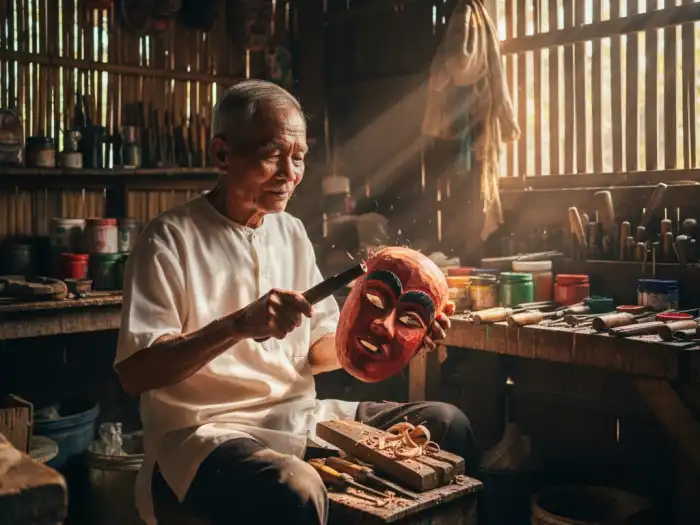
✝️ Moriones Festival History & Cultural Meaning
Before the masks, the parades, and the flashing cameras, the Moriones Festival began as an act of panata – a solemn vow made in faith. It’s one of the oldest and most iconic Holy Week observances in the Philippines, tracing its roots back to the 1600s in Mogpog, Marinduque.
🪶 Origins of the Tradition
According to local historians, the Moriones began when Father Dionisio Santiago, a Spanish friar, introduced a Lenten practice to dramatize the story of Saint Longinus – the Roman soldier who pierced Jesus’ side during the crucifixion.
The reenactment was meant to make scripture more relatable to local villagers. To bring the story to life, men dressed as Roman soldiers (morions) donned hand-carved masks and armor – made from wood, coconut shells, and scrap metal.
Over the centuries, what started as a small parish play grew into a full island-wide celebration – blending Catholic devotion with local artistry, performance, and folklore.
Cultural Note – What “Moriones” Means
The term Moriones comes from the Spanish word “morion,” meaning helmet. It refers to the Roman headgear worn by the costumed participants. Each “Morion” symbolizes both penance and transformation – hiding one’s face to reflect humility before God.
🎭 The Story of Longinus
Central to the festival is the tale of Longinus, a Roman centurion with one blind eye. When he pierced Christ’s side with a spear, blood touched his face – miraculously restoring his sight. Moved by faith, Longinus proclaimed his belief in Jesus and was executed by his fellow soldiers for his conversion.
This act of faith and sacrifice resonates deeply with Filipinos. It mirrors the belief that redemption comes through repentance and courage – themes that define the Moriones spirit.
Faith Insight – Why It Still Matters
For many devotees, joining the Moriones is a personal promise. Some wear the armor in exchange for a prayer granted – healing, protection, or thanksgiving. Others do it as penance, walking barefoot under the sun, carrying heavy props, or staying anonymous behind the mask all week.
🕊️ The Evolution of a Living Tradition
Through the years, the Moriones Festival has evolved – from pure religious ritual to a blend of faith, art, and tourism. Yet, it never lost its solemn heart. Today, it remains a proud symbol of Marinduque’s identity – a fusion of Spanish heritage, Filipino creativity, and unwavering devotion.
Each town now adds its own flavor:
-
Mogpog keeps the most traditional reenactments.
-
Boac stages theatrical plays with elaborate costumes.
-
Gasan celebrates with cultural parades and art contests.
Despite the modernization, the spirit remains the same – a sacred retelling of faith and forgiveness that moves both locals and travelers alike.
Cultural Gem – Hidden Behind the Mask
Ask any Morion, and they’ll tell you: “Hindi ito costume, ito ay panata.” (This isn’t a costume, it’s a vow.) The anonymity of the mask lets them serve without pride – to offer their devotion quietly, known only to God.
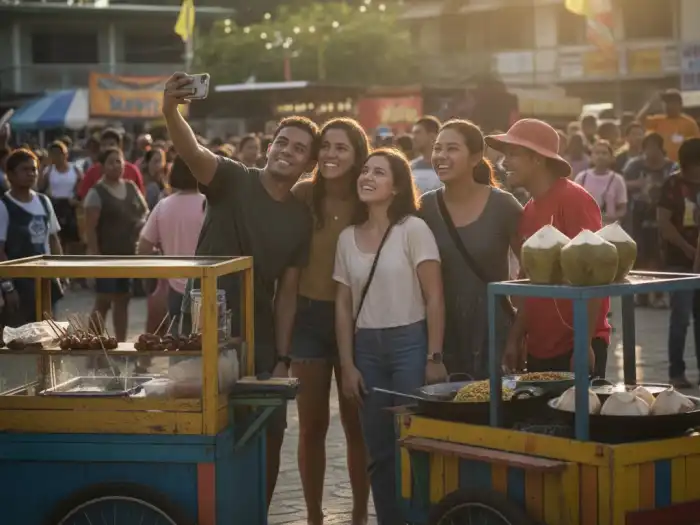
💡 Travel Hacks & Local Tips for First-Timers
The Moriones Festival isn’t just something you watch – it’s something you feel. The steady drumbeats, the shimmer of armor under the sun, and the scent of candles and sea breeze all blend into a uniquely Marinduque experience. But to truly enjoy it, a few insider moves will go a long way.
🕕 Arrive Before Holy Wednesday
The island gets busy fast – ferries are packed, hotels are full, and streets get crowded. If you want to witness the search for Longinus and the early Morion patrols, aim to arrive by Holy Monday. You’ll have time to settle in, explore, and meet locals before the Holy Week rush peaks.
Timing Trick – Catch the Calm Before the Faithstorm
The best photos and quiet reflections happen early in the week – before Good Friday’s solemn chaos begins. Stroll through Boac’s heritage streets in the morning, or watch Morions rehearse near Mogpog Plaza at sunset.
🎭 Watch in the Right Spots
Each town has its own vibe. Choose where you’ll spend Holy Week based on what you want to experience most:
| Town | What It’s Known For |
|---|---|
| Mogpog | Birthplace of the Moriones; raw, traditional atmosphere |
| Boac | Grandest parades and cathedral ceremonies |
| Gasan | Coastal scenes and cultural performances |
| Torrijos | Smaller, more personal celebrations near the sea |
Local Hack – Follow the Drums
If you’re not sure where to go, just follow the sound of the drums. It’ll lead you to where the Morions gather – sometimes in spontaneous performances or street encounters.
💰 Budget Tips for Holy Week Travelers
Marinduque stays affordable if you plan right. Here’s an average weekend budget for a 3D2N Moriones trip from Manila:
| Expense | Estimated Cost (₱) |
|---|---|
| Bus + Ferry (Round Trip) | ₱1,200–₱1,500 |
| Accommodation (2 nights) | ₱2,000–₱4,000 |
| Food & Drinks | ₱1,000–₱1,500 |
| Souvenirs & Local Treats | ₱500–₱800 |
| Total | ₱4,700–₱7,800 |
Budget Move – Eat with Locals
Instead of dining out, buy food from carinderias near churches – you’ll get hot meals for ₱80–₱120. Some families even offer free meals to pilgrims during Maundy Thursday or Easter Sunday – a quiet act of Filipino hospitality.
🧺 What to Pack
✅ Modest clothes (avoid sleeveless or short shorts)
✅ Hat, sunglasses, and sunscreen
✅ Portable fan or pamaypay
✅ Water bottle (refillable)
✅ Small towel or handkerchief
✅ Power bank and extra charger
✅ Flashlight (for Black Saturday vigils)
✅ Rosary or prayer booklet (many locals bring theirs)
Traveler’s Secret – Stay Grounded and Grateful
The Moriones isn’t a tourist show – it’s faith in motion. Observe respectfully, avoid blocking processions for selfies, and take quiet moments to appreciate the meaning behind the masks and rituals.
🚶 Explore the Island Beyond the Festival
Once Easter Sunday ends, the island slows down again – perfect for sightseeing. Don’t rush home. Instead, take a day or two to unwind:
🌅 Poctoy White Beach (Torrijos) – clear waters, soft sand, and sunset views.
⛰️ Mount Malindig – for hikers who want a panoramic island view.
🏛️ Boac Museum – small but rich in Moriones history.
🌊 Maniwaya Island – hop on a banca to this tropical mini-paradise.
Island Tip – Rent a Motorbike
Locals rent scooters for around ₱800 per day. It’s the best way to explore beaches, markets, and churches without relying on the limited tricycles during Holy Week.
❤️ A Festival of Faith, Not Performance
Remember: The Moriones Festival isn’t meant to entertain – it’s meant to renew. Behind every mask is a prayer, behind every drumbeat is devotion. Whether you’re Catholic or not, you’ll feel that spiritual energy in the air.
So come with respect, curiosity, and an open heart. Because when you experience Marinduque’s Moriones Festival, you’re not just watching faith – you’re walking through it.
❓ FAQs About Moriones Festival 2026
1. When is the Moriones Festival 2026 celebrated?
The Moriones Festival 2026 will be held during Holy Week, from March 29 (Palm Sunday) to April 5 (Easter Sunday), on the island province of Marinduque.
2. Where is the Moriones Festival celebrated?
It takes place across several towns in Marinduque, mainly in Boac, Mogpog, and Gasan, with smaller celebrations in Torrijos, Santa Cruz, and Buenavista.
3. What is the Moriones Festival about?
The festival reenacts the story of Saint Longinus, the Roman soldier who pierced Christ’s side and later converted to Christianity after being healed of blindness.
4. Why do people wear masks in the Moriones Festival?
The wooden masks represent Roman soldiers (morions) and are worn as an act of panata – a religious vow or thanksgiving. Each mask is handmade and unique to its wearer.
5. Who started the Moriones Festival?
It is believed to have begun in the 1600s in Mogpog, introduced by Father Dionisio Santiago, a Spanish friar who used dramatization to teach biblical stories.
6. What are the main highlights of the Moriones Festival?
Highlights include the street reenactments of Longinus’ story, the Good Friday crucifixion play, and the Easter Sunday parade, where Morions remove their masks in thanksgiving.
7. Is there an entrance fee to the Moriones Festival?
No – the festival is free and open to the public. However, visitors should donate or buy from local stalls to help support the community.
8. How do you get to Marinduque for the festival?
From Manila, take a bus to Lucena Port (₱400–₱500), then a RORO ferry to Balanacan or Cawit Port (₱200–₱300). Total travel time is around 6–8 hours.
9. What should tourists wear during the Moriones Festival?
Dress modestly, especially when visiting churches or processions. Light clothes, hats, and comfy shoes are recommended since it gets hot and crowded.
10. What makes the Moriones Festival unique?
Unlike most Philippine fiestas, the Moriones is both a religious vow and a theatrical art form. It’s one of the oldest living Holy Week traditions, blending faith, performance, and local craftsmanship into a sacred celebration.
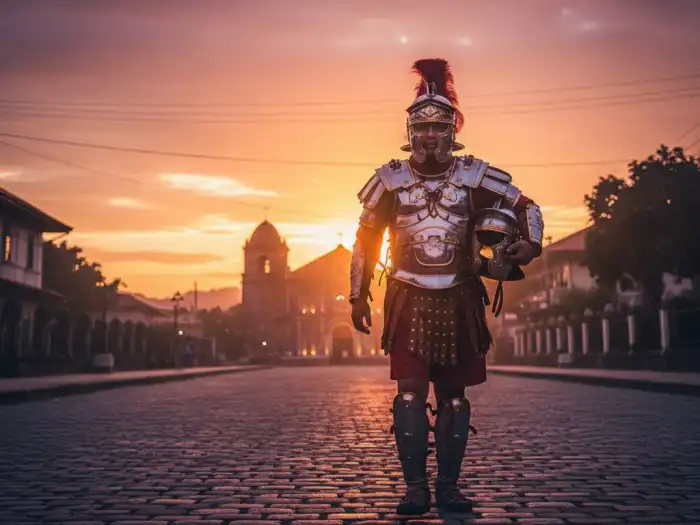
🌅 Walk Through Faith and History in Marinduque
The Moriones Festival 2026 isn’t just another event to tick off your travel list – it’s a journey into faith, heritage, and the Filipino heart. Here, devotion wears a mask, and every drumbeat echoes stories that have survived for centuries.
As you walk through the streets of Marinduque, you’ll see more than costumes. You’ll see fathers passing their faith to sons, mothers selling snacks to support their panata, and children watching wide-eyed as the Morions march past – part prayer, part play, all heart.
So if you’ve been longing for a Holy Week experience that goes beyond the usual beaches and staycations, make it Marinduque. Come humble, come curious. And let the island remind you that faith can be both solemn and beautiful – alive in every mask, every vow, and every step taken in grace. 🙏✨
🧭 References
-
Wikipedia – Moriones Festival
-
Globe Travel – Beyond the Mask: Exploring the Moriones Festival’s History
-
Mogpog Municipal Government – “Moriones”
-
Tourism Promotions Board Philippines – Moriones Festival
-
DiscoverPhilippines.org – The Moriones Festival of Marinduque



